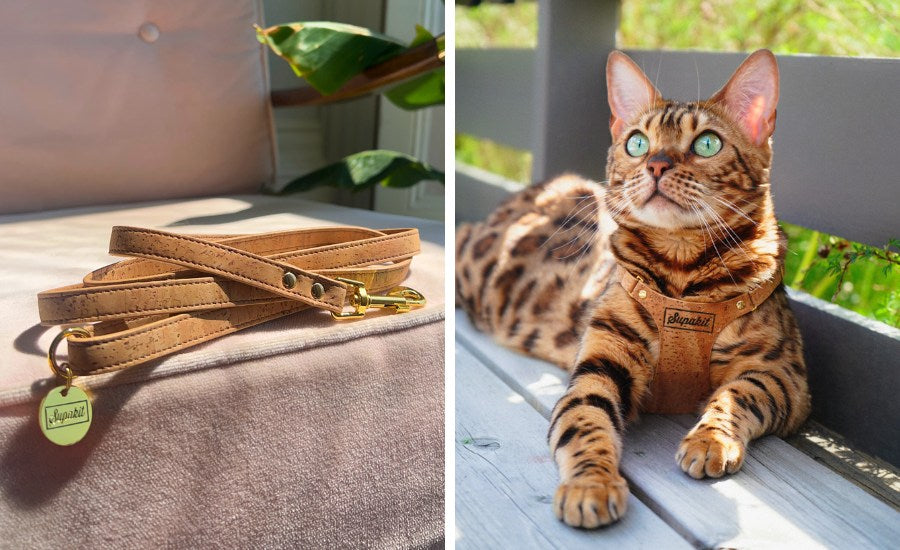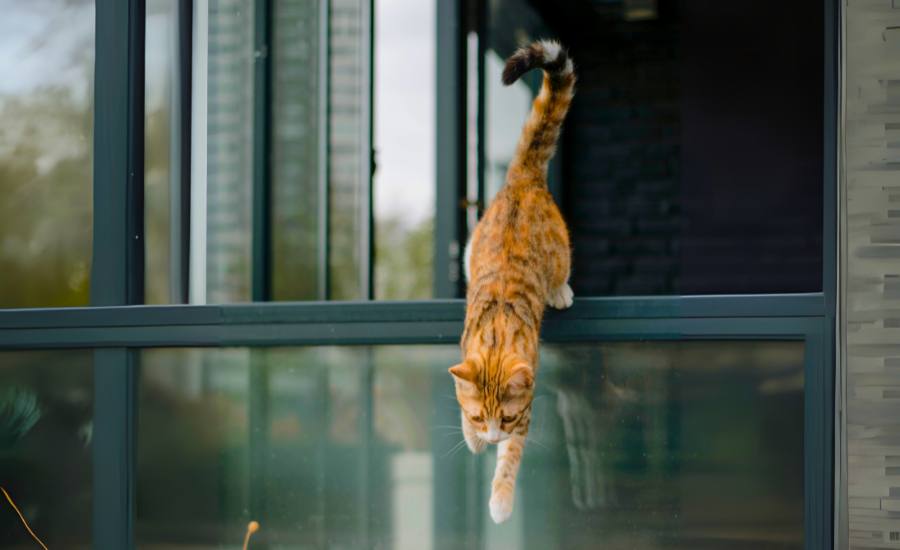Transitioning an Outdoor Cat to Life Indoors

Are you curious about transitioning your outdoor-roaming cat to life as an indoor-only kitty?
This is a topic that’s close to my heart as I’m an animal behaviour technician and it’s something I successfully accomplished with my own cat Lola. She was an outdoor/indoor kitty for her first five years, a real explorer, and has happily transitioned to being an indoor cat for the past three years.
You might have your own reasons for considering doing this, but in brief these were mine:
-
Safety Concerns: We had put a GPS tracker on Lola and discovered that she was routinely leaving our quiet close and crossing a major road, at night. One time, she had even got trapped on the other side of the road – possibly due to cars, or predators, we’re not sure – and we only found her three days later after an exhaustive and heartbreaking search. It felt like only a matter of time until her luck ran out and she ended up being hit by a car.
-
Anxiety Due to Other Cats: We lived in an area where the density of cats was very high, and I observed that Lola’s body language whilst outside was very anxious. She spent most of the day sat atop a fence post in a hunched position, showing signs of anxiety like lip licking and a low crouched posture. Her outside time wasn’t making her particularly happy.
-
Hunting: Lola was an avid hunter. She brought in multiple birds, frogs, mice and rats – some alive, some dead. We put a collar and bell on her which did help a little, but did not prevent her hunting activities entirely.
- Neighbour Concerns: Lola would freely enter neighbours' houses in the summer when their patio doors were open. One neighbour, who was very afraid of cats, found Lola in her bedroom one evening and was terrified. I couldn’t think of a way to prevent this from reoccurring without impinging on our neighbours' comfort.
I make her sound like a delinquent little kitten – and maybe she was, but she is also a darling and I care deeply for Lola. So I wanted to make the transition as smooth as possible. Plus, I was aware from previous experience that if Lola is feeling unhappy, her first instinct is to toilet on my bed, so I was particularly motivated to do this right! Which brings me onto my first point – toileting…
Toileting

If your cat currently only toilets outside (as was the case with Lola), your first task is to introduce them to toileting in a litter tray. I would begin this while your cat still has free access outside.
Use a large, open litter tray that is easy for your cat to get in and out of. Position it in a calm area of the house, ideally on the route they would normally take to go outside to toilet.
If your kitty is lazy or has actually been concerned about toileting outside because they’re worried about other neighbourhood cats, you might find that they take to it straight away.
Or, you might find that they’re not sure about the litter because it’s so different to what they’ve been using. In that case, you can start by filling the litter tray with garden soil from their preferred toileting site, and then gradually reduce the amount of soil and increase the amount of commercial litter that you mix in.
You might also find that they just love going outside and are finding that habit hard to shake. In that scenario, I’d recommend that you start by keeping your kitty in at night. Try and get them in the ‘mood’ to go to the toilet with a nice game of play, for instance with a feather wand toy. Then feed them their evening meal. Then cross your fingers and hope that they make their way to the tray (don’t hover over it though, they’ll sense your desperation!).
One last note – I’m not sure if this is common in cats that have had outdoor access for toileting, but it’s a hunch. My cat Lola is extremely fastidious about litter tray cleanliness. She has two trays that are cleaned thoroughly (not just scooped) daily. If they aren’t spotless, she refuses to use them. I suspect that, when she was outdoors, she could always find a fresh, clean spot of earth, and she’s grown to expect that level of cleanliness. I wanted to mention this in case your cat feels the same and you’re wondering why they won’t use their trays!
Enrichment

With the toileting conundrum solved, we still have some other things to work on. The big idea is to replicate the fun activities your cat enjoyed outside, indoors.
First, think about the 3D space your cat gets to explore outside. Maybe they like to climb trees like my Lola did, or perhaps they like to paw their way across high fences, or crouch under deck chairs. Provide these opportunities inside your home in a safe and suitable way.
For height, one of the best options is a cat tree. Find one that’s sturdy and ideally screw it into the wall if possible. For hiding low down, I like to use cat caves – but cardboard boxes work equally well and can be chewed on, replicating another outdoor behaviour.
Scratching is a natural behaviour, so provide both horizontal and vertical scratchers at key routes in your home. Ensure they are sturdy and don’t wobble when your cat uses them.
It’s also a good idea to provide some cat-safe plants indoors. My favourites are cat grass and cat mint plants, which I’ve had good success growing indoors. Place these at your cat’s key routes so they can munch as they pass.
For hunting, provide a feather wand toy and play with your cat, especially in the mornings and evenings. If your cat ‘doesn’t like to play’, you can try this trick that I use at the sanctuary where I help to socialise rescue cats - spread a newspaper or lightweight blanket on the floor and poke the feather toy underneath it to simulate a hunting scenario. Remember to ‘get into the mind of the rodent’ and play dead when your cat pounces, and then let your kitty get their paws on the prey (the feather toy) in the end!
Meowing to go out

It’s natural for your cat to go through a period of confusion and frustration when the long-established rules of their world change – suddenly the cat flap or door that used to lead to the outside part of their territory has stopped working and they need the human to “FIX IT, NOW!”.
Changing the visual cues your cat receives in this part of your home can signal that things are different now. For example, remove and close over the cat flap or place a distraction, such as an activity feeder, at the back door. It’s very important not to respond to your cat’s meows to go outside by thinking, “I’ll let them out just this once.” That will teach them that they can go outside if they meow hard and long enough.
Initially, your cat’s meowing might escalate as they try harder to catch your attention, but as long as you remain calm and consistent in not letting them out, and instead distract them with treats and fun play, the meows will eventually end. For my cat Lola, it took a couple of weeks for her to stop fixating on the back door altogether.
Harness training
Another great way to offer your cat some of the enrichment they got outside, but in a safe and controlled way, is to consider harness training them. I recommend waiting until your cat is happy and settled indoors and you’ve completed all the previous steps. We have a free harness training bootcamp available, as well as a longer, more comprehensive cat harness training course if this is something you’d like to pursue.
To replicate the outdoor experience, take your cat outside on their harness in a familiar space – for example, your back garden or a common area you can return to regularly. Try to go out at a consistent time each day. This allows your cat to scent mark the area (by rubbing their cheeks on plants and objects they pass) and revisit these scent marks daily for familiarity.
It's also best to carry your cat outside in a carrier, backpack, or stroller, rather than letting them walk on their own, to help break their previous association with crossing the threshold to go outside.
Picking the same daily spot for your walks doesn’t mean you can’t explore other areas too if your cat shows interest, but personally, I find that my daily 15-minute strolls around the garden with Lola on her harness and leash are the most fulfilling for her, and incidentally, for me too. I take a cup of coffee and enjoy some time in nature, led by her.
Conclusion
Transitioning an outdoor cat to indoor life takes time and patience, but with these tips, you can make the process smoother and more enjoyable for both you and your kitty. Remember, every cat is different, so be patient and adjust your approach based on your cat's comfort and responses.
Best of luck with your transition! If you have any questions or want to share your experiences, feel free to reach out in our private Facebook group – the Supakit Cat Collective.







